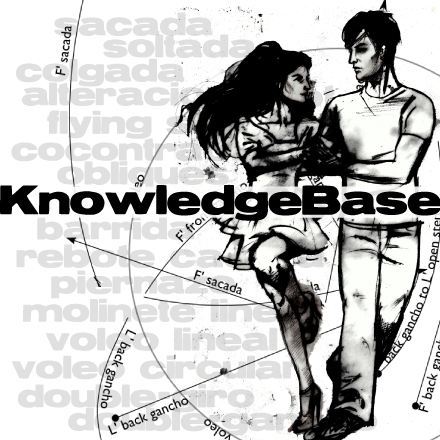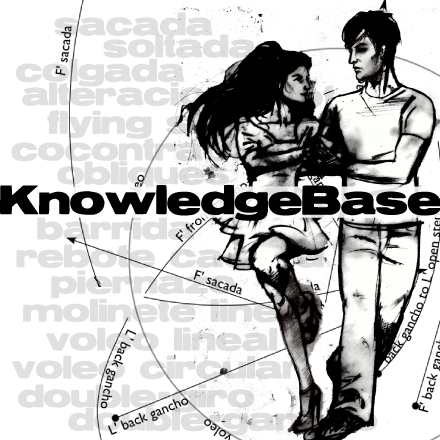See giro for disambiguation.
There are three giros: double-giro (both partners walk), single-giro (Mark is in the center of the circle, Revel walks), and calesita (single-giro with Revel in center of the circle, Mark walks).
Technique
Both partners support the movement through:
- Vigilant attention to their arcs.
- Using obliques to pivot.
- Supporting one another with stronger than usual external rotation of shoulder joints and contraction of triceps. (Not with tension in hands!)
Improvisation
The Mark works with several variables for improvisation:
- Direction of the walk.
- Allowing lateral shoulder flexion or not. (Lateral shoulder flexion allows him to walk alone, leaving the revel in place, thus increasing torsion.)
- Effects of his front, back (not shown), and side steps. (His side step can be used to create lateral projection to shift the Revel’s leg from front to back projection.)
- Creating a projection toward his body for a patada. It can be pro or contra. A pro patada (not contra, no elasticity, no release) can be transformed into a Revel’s gancho by stepping through her projected leg.
The Revel improvises in three dimensions:
- Maximize the projection: This is your ballerina on top of the jewelery box moment. Enjoy it! Make the projection beautiful. First ensure that your leg is projected directly front, side, or back (not on a diagonal). Be sure your toe is pointed. Then maximize in one of three ways:
[1] Make your leg longer by flexing your base leg’s knee and extending fully the free leg’s knee.
[2] Lift your leg into an arabesque. Free leg’s knee should be extended in side projection, can be bent in front and back projection.
[3] Go to front or back circular voleo. - Work with the changing torsion resulting from the tension between your free leg and the position of the mark’s body moving around you on the circle. When he leaves you in place and moves behind you, stay in place with beautiful projection and wait for the torsion to increase. When the torsion is maximized, then pivot, first your base, leaving your free leg’s projection where it is. Then enjoy the effects on your free leg.
- Feel for the space to pass through changing the direction of your projection. Often the Mark will mark a lateral projection during his side step to release you front front or back projection so you can change. (But he can also not allow it, so that he takes that step, but you stay in position.) Feel for space!
- Pay attention to the possibility of a mark directly toward the mark – this is patada.
Transition from double-giro or Mark’s single-giro to calesita:
Explore the effects of the Mark’s variables at different points in the Revel’s molinete. These aren’t rules, because everything is possible, just some things to notice:
- If the Revel is in first or second projection of a front step when the Mark starts the calesita, it’s comfortable and creates good torsion to move in the same direction as the prior giro.
- If the Revel is in a first or second projection of a back step when the Mark starts the calesita, it’s comfortable if he changes the direction of the prior giro.
Transition from cross or parada to calesita
Calesita can begin with the Revel standing in two feet: from a parada mid-transfer or from a cross. In this case the Revel pivots as long as possible on two feet. At the point when the torsion reaches the limit of her arch, she deweights one leg and then maximizes its projection, then proceeding as above.











